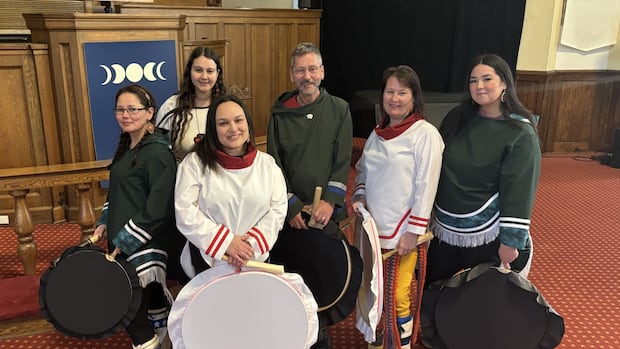Unreserved50:51The strength of Inuit drum dancing
Sophie Agnatok and Ashley Dicker have known each other for decades. Today, they’re closer than ever — in more ways than one.
“We’re right in each other’s faces,” Agnatok said, referring to how, as throat singing partners, they perform up close to one another.
“It’s really intimate, and it requires so much focus and so much connection.”
Dicker’s first memories of Agnatok go back to their childhood in Nain, Nunatsiavut, an Inuit-governed region in northern Labrador.
“When I was a young girl, I would break into Sophie’s bedroom with my best friend, who was her sister, and I would steal her perfume,” Dicker said, laughing.
Agnatok and Dicker are members of Kilautiup Songuninga, which translates to “strength of the drum.” They’re the first Inuit drum dancing and throat singing group to come out of St. John’s. Agnatok is now the group’s president. As a founding member, she has been part of the group for nineteen years. Dicker joined four years ago.
“Before we even had Ashley, I’d been dying and dying for a throat singing partner. I finally got one,” said Agnatok. “I’m very, very lucky to have her.”
For the last two decades Kilautiup Songuninga has been gathering songs and stories to revive the age-old tradition of Inuit drum dance. Although the songs were often performed by men, it’s women who are leading the resurgence.
For the six members of Kilautiup Songuninga, community is part of its draw.
“It’s hard for Inuit to gather here,” Dicker said. She moved to St. John’s eight years ago and joining the group has helped her combat homesickness. “It’s so good to be somewhere [you can be yourself], or with people you could be yourself with.”
Reclaiming culture
Kilautiup Songuninga also helps its members recover aspects of their culture that many of them grew up without access to.
“When we had started, we did not know our traditions, it wasn’t brought up. We weren’t taught our songs, we were taught church music,” Agnatok said.
Throat singing and drum-dancing were feared and banned by Moravian missionaries who saw it as devil worship. In place of traditional Inuit music, they forced the adoption of brass instruments and choral singing.
Agnatok was raised by her grandmother, herself a throat singer. That legacy inspired Agnatok, though her grandmother did not teach her the practice.
“I was cleaning up one day and I found this newspaper clipping, and it was my grandmother. She was here [in Newfoundland] for the Folk Festival back in 1984. And I’m like, wow,” Agnatok said.
Dicker’s journey into traditional music was ignited by a similar passion for revitalizing her culture. She never saw her grandparents or other elders in her community practising their musical traditions.
“I wanted our elders to see us … I wanted them to see us being proud and fighting to take it back — and being proud for ourselves, but especially for the people who weren’t allowed to be proud of themselves.”
Learning process
Growing up, Agnatok saw the Nain Drum Dancers reclaiming drum dancing in her hometown. She points to Nunatsiavut becoming self-governed in 2005 as an inciting moment for further reconnection to Inuit culture, including through Kilautiup Songuninga.
Learning techniques and songs that were almost lost comes with its share of challenges for the group. They rely on a variety of sources, including CDs, the internet and Inuit knowledge keepers to build their repertoire.
“It can be a little bit hard, trying to get the technique down and get the right music down,” Agnatok said.
Language, in particular, can be a hurdle.
“A lot of our members … we’re not full Inuit speakers like a lot of our ancestors are, or even some of our elders now,” Agnatok said. “But we want to make sure we sing properly when we do sing in Inuktitut, our mother tongue.”
‘Inuk to the core’
Over almost two decades, Kilautiup Songuninga’s linuep has changed. Last December, founding member Solomon Semigak died.
“He was just special,” said Danny Pottle, who was invited to join the group in 2004. “Taught us with patience, with skill, and he was just an all around good guy. You just couldn’t ask for a better person than Solomon. He was Inuk to the core.”
Agnatok remembers Semigak as a strong Inuktitut speaker, a diplomatic group president, and her once right-hand man.
“We drum on. We still talk about him,” Agnatok said. “I know he would be so proud of all of us, believe me. And with his niece joining the drum group, that’s a big thing too.”
New member Sophie Semigak joined the group early this year, in memory of her uncle.
“He was like a father to me,” she said. “He walked me down the aisle, too, when I got married. So he’s very, very special to me.”
Agnatok says Semigak would be proud to see his niece drumming.
“We may head butt like family, but we are all family. We all support each other too, in our own way. And that’s what it’s all about,” she said.

